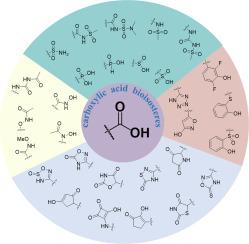羧酸类生物异构体在药物结构优化中的应用
IF 5.9
2区 医学
Q1 CHEMISTRY, MEDICINAL
引用次数: 0
摘要
羧酸是药物化学中最常见的官能团之一,但其固有的局限性包括膜渗透性差,代谢不稳定和有限的血脑屏障穿透性,需要创新的结构修饰。本文综述了羧酸生物异构体作为药物结构优化的基本策略的应用,分析了它们的结构-性质关系、合成可及性和治疗应用。通过实验数据和计算模型系统地评估了各种生物等构替代物,包括羟肟酸、磺酸、方酸衍生物、杂环系统、含磷基团和硼酸。分析表明,成功的生物等压替代需要在维持关键的药效相互作用和优化物理化学性质之间取得谨慎的平衡。羟基肟酸在金属酶抑制中表现出特殊的效用,而四唑类和恶二唑类具有类似的结合亲和力,可以改善代谢稳定性。新型支架,如环磺酰酰胺和角酰胺,可增强膜通透性和血脑屏障穿透性。包括平均电子密度计算和分子动力学模拟在内的定量方法提供了对生物等衡关系的机制见解。多种含生物异构体药物在不同治疗领域的成功临床翻译验证了这种方法。本文为合理选择和应用羧酸类生物异构体建立了一个实用的框架,为药物化学家进行先导物优化和药物开发规划提供了有价值的指导。本文章由计算机程序翻译,如有差异,请以英文原文为准。

Application of Carboxylic Acid Bioisosteres in Drug Structure Optimization
Carboxylic acids represent one of the most prevalent functional groups in pharmaceutical chemistry, yet their inherent limitations including poor membrane permeability, metabolic instability, and limited blood-brain barrier penetration necessitate innovative structural modifications. This comprehensive review examines the application of carboxylic acid bioisosteres as a fundamental strategy in drug structure optimization, analyzing their structure-property relationships, synthetic accessibility, and therapeutic applications. Various bioisosteric replacements including hydroxamic acids, sulfonic acids, squaric acid derivatives, heterocyclic systems, phosphorus-containing groups, and boronic acids are systematically evaluated through experimental data and computational modeling. The analysis reveals that successful bioisosteric replacement requires careful balance between maintaining critical pharmacophoric interactions and optimizing physicochemical properties. Hydroxamic acids demonstrate exceptional utility in metalloenzyme inhibition, while tetrazoles and oxadiazolones offer improved metabolic stability with comparable binding affinity. Novel scaffolds such as cyclic sulfonimidamides and squaramides provide enhanced membrane permeability and blood-brain barrier penetration. Quantitative approaches including average electron density calculations and molecular dynamics simulations provide mechanistic insights into bioisosteric relationships. The successful clinical translation of multiple bioisostere-containing drugs across diverse therapeutic areas validates this approach. This review establishes a practical framework for rational selection and application of carboxylic acid bioisosteres, offering valuable guidance for medicinal chemists in lead optimization and drug development programs.
求助全文
通过发布文献求助,成功后即可免费获取论文全文。
去求助
来源期刊
CiteScore
11.70
自引率
9.00%
发文量
863
审稿时长
29 days
期刊介绍:
The European Journal of Medicinal Chemistry is a global journal that publishes studies on all aspects of medicinal chemistry. It provides a medium for publication of original papers and also welcomes critical review papers.
A typical paper would report on the organic synthesis, characterization and pharmacological evaluation of compounds. Other topics of interest are drug design, QSAR, molecular modeling, drug-receptor interactions, molecular aspects of drug metabolism, prodrug synthesis and drug targeting. The journal expects manuscripts to present the rational for a study, provide insight into the design of compounds or understanding of mechanism, or clarify the targets.

 求助内容:
求助内容: 应助结果提醒方式:
应助结果提醒方式:


